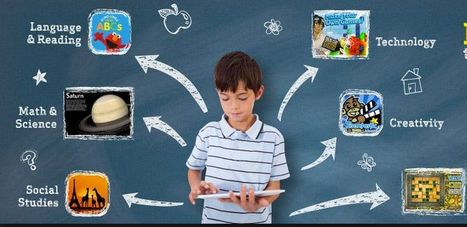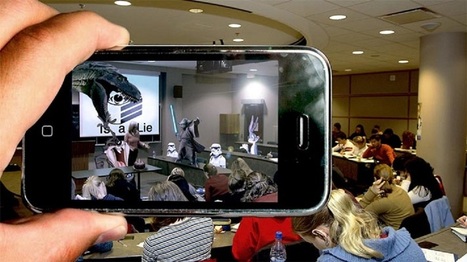Our colleagues in Online Universities have generously shared with us this list featuring 20 ways Augmented Reality is being used in education. If you are not familiar with what Augmented Reality is all about, check "teachers' guide to Augmented Reality" to learn more.
Research and publish the best content.
Get Started for FREE
Sign up with Facebook Sign up with X
I don't have a Facebook or a X account
Already have an account: Login

News on Augmented Reality, Virtual Reality, Mixed Reality, UX/UI Designer, Internet of Things, Artificial intelligence, Quantum Computing, continually updated from thousands of sources around the net.
Curated by
Mirko Compagno
 Your new post is loading... Your new post is loading...
 Your new post is loading... Your new post is loading...
|
|











Second Life:
Second Life proved an incredibly valuable tool for educators hoping to reach a broad audience — or offering even more ways to learn for their own bands of students.
Augmented Reality Development Lab:
Affiliated with Google, Microsoft, and Logitech, the Augmented Reality Development Lab run by Digital Tech Frontier seeks to draw up projects that entertain as well as educate. The very core goal of the ARDL involves creating interactive, three-dimensional objects for studying purposes.
Reliving the Revolution:
Karen Schrier harnessed GPS and Pocket PCs to bring the Battle of Lexington to her students through the Reliving the Revolution game, an AR experiment exploring some of the mysteries still shrouding the event — like who shot first! Players assume different historical roles and walk through everything on a real-life map of the Massachusetts city.
PhysicsPlayground:
One of the many, many engines behind PC games received a second life as an engaging strategy for illustrating the intricate ins and outs of physics, in a project known as PhysicsPlayground. It offers up an immersive, three-dimensional environment for experimenting, offering up a safer, more diverse space to better understand how the universe drives itself.
MITAR Games:
Developed by MIT’s Teacher Education Program and The Education Arcade, MITAR Games blend real-life locations with virtual individuals and scenarios for an educational experience that research proves entirely valid. Environmental Detectives, its first offering, sends users off on a mystery to discover the source of a devastating toxic spill.
New Horizon:
As a smartphone app, it takes advantage of built-in cameras to present animated character conversations when aligned with certain sections of pages.
Occupational Safety Scaffolding:
Professor Ron Dotson’s Construction Safety students receive a thorough education in establishing safe scaffolding space through three-dimensional demonstrations incorporating the real and the digital alike. A simple application of AR, to be certain, but one undoubtedly possessing the potential to save lives and limbs alike.
FETCH! Lunch Rush:
Education-conscious parents who want L’il Muffin and Junior to learn outside the classroom might want to consider downloading PBS Kids’ intriguing iPhone and iPod Touch app. Keep them entertained in the car or on the couch with a fun little game for ages six through eight meant to help them build basic math skills visually.
Field trips:
Augmented reality museums guide students and self-learners of all ages through interactive digital media centered around a specific theme — maybe even challenge them to play games along the way. HistoriQuest, for example, started life as the Civil War Augmented Reality Project and presented a heady blend of mystery gaming and very real stories.
School in the Park Augmented Reality Experience:
Third graders participating in the 12-year-old School in the Park program engage with AR via smartphones as they explore Balboa Park, the San Diego History Center, and the world-class San Diego Zoo. Not only do they receive exposure to numerous educational digital media resources, teachers also train them in creating their very own augmented reality experiences!
QR Code scavenger hunts:
Smartphones equipped with a QR code reader make for optimal tools when sending students on scavenger hunts across the classroom or school. The Daring Librarian, Gwyneth Anne Bronwynn, sends kids on an augmented reality, animated voyage through the library to figure out where to find everything and whom to ask for assistance.
Mentira:
Mentira takes place in Albuquerque and fuses fact and fiction, fantasy characters and real people, for the world’s first AR Spanish language learning game. It intentionally mimics the structure of a historical murder mystery novel and allows for far deeper, more effective engagement with native speakers than many classroom lessons.
Driver’s ed:
Toyota teamed up with Saatchi & Saatchi to deliver the world’s cleanest and safest test-drive via augmented reality. While the method has yet to catch on in the majority of driver’s education classes, it definitely makes for an impressive, effective alternative to keeping and maintaining a fleet of cars.
Geotagging:
Classrooms with smartphone access blend Google Earth and web albums such as Picasa or Instagram for a firsthand experience in geotagging and receiving a visual education about the world around them. More collaborative classrooms — like those hked together with Skype or another VOIP client – could use this as a way to nurture cross-cultural, geopolitical understanding.
Dow Day:
Jim Mathews’ augmented reality documentary and smartphone app brought University of Madison-Wisconsin students, faculty, staff, and visitors to the year 1967. As they traveled campus, participants’ smartphones called up actual footage of Vietnam War protests corresponding with their current locations.
SciMorph:
Using a webcam and printed target, young kids in need of some science (although, really, everyone is in need of some science) interact with the cute critter SciMorph, who teaches them about gravity, sound, and microbial structures. Each lesson involves exploring a specific zone within the game and opens users up to questions, quizzes, and talks.